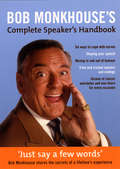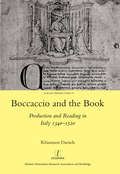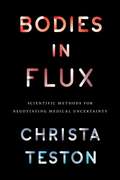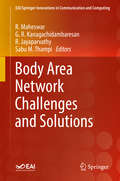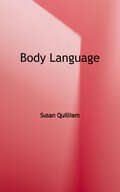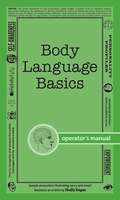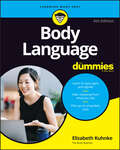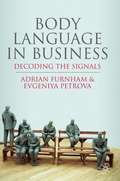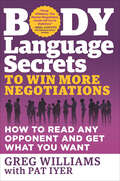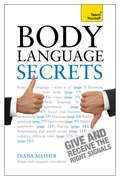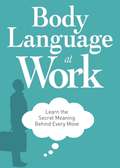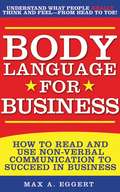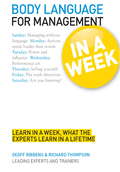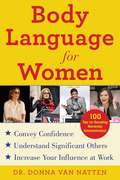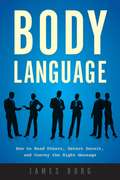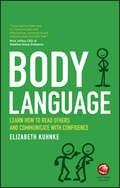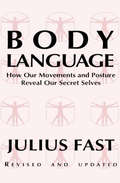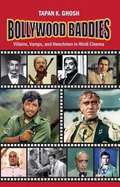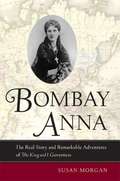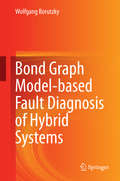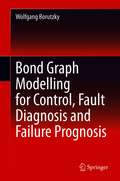- Table View
- List View
Bob Monkhouse's Complete Speaker's Handbook
by Bob MonkhouseDiscover Bob Monkhouse's secrets accumulated from a lifetime's experience in scriptwriting and speechmaking. With his own golden rules, advice and examples from fellow experts and famous friends, and a wealth of humorous material that worked for him, this light-hearted yet thoroughly practical handbook ensures that you will always be ready to say a few words.
Boccaccio and the Book: Production and Reading in Italy 1340-1520
by Rhiannon DanielsAs a new digital era increasingly impacts on the 'age of print', we are ever more conscious of the way in which information is packaged and received. The influence of the material form on the reading process was no less important during the gradual shift from manuscript to early print culture. Focusing on the physical structure and presentation of manuscripts and printed books containing texts by one of the most influential authors of the medieval period, Rhiannon Daniels traces the evolving social, cultural, and economic profile of Boccaccio's readership and the scribes and printers who laboured to reproduce three of his works: the Teseida , Decameron , and De mulieribus claris . Rhiannon Daniels is a British Academy Postdoctoral Fellow in the Department of Italian at the University of Leeds.
Bodies in Flux: Scientific Methods for Negotiating Medical Uncertainty
by Christa TestonDoctors, scientists, and patients have long grappled with the dubious nature of “certainty” in medical practice. To help navigate the chaos caused by ongoing bodily change we rely on scientific reductions and deductions. We take what we know now and make best guesses about what will be. But bodies in flux always outpace the human gaze. Particularly in cancer care, processes deep within our bodies are at work long before we even know where to look. In the face of constant biological and technological change, how do medical professionals ultimately make decisions about care? Bodies in Flux explores the inventive ways humans and nonhumans work together to manufacture medical evidence. Each chapter draws on rhetorical theory to investigate a specific scientific method for negotiating medical uncertainty in cancer care, including evidential visualization, assessment, synthesis, and computation. Case studies unveil how doctors rely on visuals when deliberating about a patient’s treatment options, how members of the FDA use inferential statistics to predict a drug’s effectiveness, how researchers synthesize hundreds of clinical trials into a single evidence-based recommendation, and how genetic testing companies compute and commoditize human health. Teston concludes by advocating for an ethic of care that pushes back against the fetishization of certainty—an ethic of care that honors human fragility and bodily flux.
Bodies in Flux: Scientific Methods for Negotiating Medical Uncertainty
by Christa TestonDoctors, scientists, and patients have long grappled with the dubious nature of “certainty” in medical practice. To help navigate the chaos caused by ongoing bodily change we rely on scientific reductions and deductions. We take what we know now and make best guesses about what will be. But bodies in flux always outpace the human gaze. Particularly in cancer care, processes deep within our bodies are at work long before we even know where to look. In the face of constant biological and technological change, how do medical professionals ultimately make decisions about care? Bodies in Flux explores the inventive ways humans and nonhumans work together to manufacture medical evidence. Each chapter draws on rhetorical theory to investigate a specific scientific method for negotiating medical uncertainty in cancer care, including evidential visualization, assessment, synthesis, and computation. Case studies unveil how doctors rely on visuals when deliberating about a patient’s treatment options, how members of the FDA use inferential statistics to predict a drug’s effectiveness, how researchers synthesize hundreds of clinical trials into a single evidence-based recommendation, and how genetic testing companies compute and commoditize human health. Teston concludes by advocating for an ethic of care that pushes back against the fetishization of certainty—an ethic of care that honors human fragility and bodily flux.
Body Area Network Challenges and Solutions (EAI/Springer Innovations in Communication and Computing)
by Sabu M. Thampi R. Maheswar G. R. Kanagachidambaresan R. JayaparvathyThis book provides a novel solution for existing challenges in wireless body sensor networks (WBAN) such as network lifetime, fault tolerant approaches, reliability, security, and privacy. The contributors first discuss emerging trends of WBAN in the present health care system. They then provide possible solutions to challenges inherent in WBANs. Finally, they discuss results in working environments. Topics include communication protocols of implanted, wearable and nano body sensor networks; energy harvesting methodologies and experimentation for WBAN; reliability analysis and fault tolerant architecture for WBAN; and handling network failure during critical duration. The contributors consist of researchers and practitioners in WBAN around the world.
Body Language
by Susan QuilliamIn an increasingly complex and fast-moving world body language can be the key to success or failure. "Body Language" explores this unspoken language and shows us how to interpret the signals we receive and how to control the messages we send. Starting with such broad basics as first impressions and territorial behaviour, the book moves on to study the body signals we are likely to give out in specific situations, such as parties and social gatherings, the workplace, and sexual relationships. A look at deception, and the contradictions that can occur between words and actions, is finally followed by an easy-to-read, visual dictionary of body language, showing key gestures with their meanings.
Body Language Basics: How to analyze and recognize the subtle messages sent by someone's body
by Shelly HagenStare or glare—which is it? If you can&’t read the visual clues of body language, you could lose a lot in the translation. Body Language Basics makes you fluent in no time. Whether you&’re trying to get a read on a new client&’s willingness to make a deal or wondering if your date&’s down-turned gaze indicates disinterest or coyness, Body Language Basics shows you how to get a better read on the subconscious signals people send your way.
Body Language For Dummies
by Elizabeth KuhnkeAre your words and your body telling the same story? Discover the impact that nonverbal behavior has on communication Much of a message’s meaning comes through what’s not being said. To master the art of clear communication, you need to be able to read others’ body language and remain mindful of the messages your own gestures, movements, and facial expressions are sending. Body Language For Dummies shows you how to interpret nonverbal cues at work and in your personal life. With the help of this easy-to-follow Dummies guide, you can navigate the gap between words and meaning—even in multicultural settings. Plus, this updated edition goes virtual, with new insights demonstrating the significance of facial expressions and body language in online vs. in-person meetings. Gain insight into other people’s thoughts, feelings, and intentions Develop an awareness of how your body language influences others’ opinions Make the camera your friend during virtual meetings Learn tips and tricks to uncover people’s real attitudes and motivationsIf you want to better understand others and improve your own communication skills (and who doesn’t?), this is the Dummies book for you.
Body Language In Business
by Adrian Furnham Evgeniya PetrovaThis innovative new work clarifies the misconceptions aroundbody language while providing a scientific approach to understanding non-verbal communicationat work. The authors explain why it is so important to understand body language in business, combining hard research evidence with unambiguous tips and practical applications.
Body Language Secrets to Win More Negotiations: How to Read Any Opponent and Get What You Want
by Greg Williams Pat Iyer“Full of techniques from deciphering hidden body language messages to enhancing your negotiation strategies. . . . your go-to resource for stellar results.” —Harvey Mackay, #1 New York Times–bestselling author of Swim With the Sharks Without Being Eaten AliveThe success of a negotiation is profoundly affected by how well you read body language. How can you learn to read the subtle clues—many lasting a fraction of a second—that your opponent projects? Body Language Secrets to Win More Negotiations will help you discover what the “other side” is revealing through body language and microexpressions, and how to control your own. It will help you become more adept at leveraging your knowledge of emotional intelligence, negotiation ploys, and emotional hot buttons. Through engaging stories and examples, Body Language Secrets to Win More Negotiations shows you how to employ a wide range of strategies to achieve your negotiating goals. You will learn:• How to employ your knowledge of body language to instantly read the other negotiator’s position.• Insider secrets that will give you an advantage in any negotiation.• Techniques to overcome common obstacles that hamper your negotiationsLearning to read and send body language signals enables anyone, anywhere, to gain an advantage in any negotiation, from where to go for brunch to what price to pay for a global corporate acquisition.“A book that should be on everyone’s must-read list.” ?Roger Dawson, author of Secrets of Power Negotiating“This practical book is loaded with proven strategies and tactics to negotiate effectively and get a better deal every time.” ?Brian Tracy, author of The Power of Self-Confidence“Greg Williams, the Master Negotiator, could sell ice to Eskimos.” ?Neil Cavuto, Fox Business News Anchor
Body Language Secrets: Teach Yourself
by Diana MatherResearch shows that our body language accounts for more than 50% of the success (or lack of it) of our communication. This book tells you how to give out the right signals, and read other people's body language. As well as body movements, this book (complete with photos) includes specific chapters on situations such as networking, meetings, public speaking, interviews, and dating.
Body Language Secrets: Use body language to succeed in any situation
by Diana MatherResearch shows that our body language accounts for more than 50% of the success (or lack of it) of our communication. This book tells you how to give out the right signals, and read other people's body language. As well as body movements, this book (complete with photos) includes specific chapters on situations such as networking, meetings, public speaking, interviews, and dating.
Body Language at Work: Learn the Secret meaning Behind Every Move
by Adams MediaRaised eyebrows, rubbing one’s chin, angled shoulders - what’s it all mean? Master the art of nonverbal communication and you’ll unlock these secrets and more. Body Language at Work is your quick course in interpreting office place body language. Now you’ll know just what your bosses and coworkers are thinking - without them having to say a word.
Body Language for Business: Tips, Tricks, and Skills for Creating Great First Impressions, Controlling Anxiety, Exuding Confidence, and Ensuring Successful Interviews, Meetings, and Relationships
by Max A. EggertBody Language for Business will show you how to understand the intricacies of body language and how to maximize your interpersonal skills in all your relationships-in your personal life and at work. This handy guide holds successful tips for not only reading others, but also showing confidence to friends, coworkers, and your boss.With Body Language for Business you'll learn:The basics of body languageHow to make a positive impact every timeTechniques for controlling anxietyWays to exude personal confidenceAnd much more!Never again will you panic during a job interview or when asking for a raise! With the help of world renowned psychologist Max A. Eggert, you'll gain insight into how to interact with colleagues in a professional and courteous manner. This guidebook is filled with life lessons that everyone, young and old, should read and abide by.
Body Language for Management in a Week: Teach Yourself (Teach Yourself In A Week Ser.)
by Richard Thompson Geoff RibbensThe ability to read people's body language and send out the right signals yourself, is crucial to anyone who wants to advance their career.Written by Geoff Ribbens and Richard Thompson, leading experts on body language, this book quickly teaches you the insider secrets you need to know to in order give a successful appraisal.The highly motivational 'in a week' structure of the book provides seven straightforward chapters explaining the key points, and at the end there are optional questions to ensure you have taken it all in. There are also cartoons and diagrams throughout, to help make this book a more enjoyable and effective learning experience.So what are you waiting for? Let this book put you on the fast track to success!
Body Language for Management in a Week: Teach Yourself (Teach Yourself In A Week Ser.)
by Richard Thompson Geoff RibbensThe ability to read people's body language and send out the right signals yourself, is crucial to anyone who wants to advance their career.Written by Geoff Ribbens and Richard Thompson, leading experts on body language, this book quickly teaches you the insider secrets you need to know to in order give a successful appraisal.The highly motivational 'in a week' structure of the book provides seven straightforward chapters explaining the key points, and at the end there are optional questions to ensure you have taken it all in. There are also cartoons and diagrams throughout, to help make this book a more enjoyable and effective learning experience.So what are you waiting for? Let this book put you on the fast track to success!
Body Language for Women: Learn to Read People Instantly and Increase Your Influence
by Dr. Donna Van NattenBodies talk. Do you know how to listen? A quick glance, a twist of the hips, or a biting of the lower lip can speak volumes about what someone is thinking or feeling. The powerful messages our bodies send can make all the difference when interviewing for a new job, going on a date, or detecting when a person is lying to you. In Body Language for Women, body language expert Dr. Donna Van Natten provides you with the tools and resources that you need to analyze the movements of those around you. She helps you detect what you are subtly and unconsciously saying with your own body and the implications these communications are having on your life. Further, Dr. Van Natten challenges you to understand the nonverbal cues of other women and men in general, your family members, and your romantic interests. Finally, she fine-tunes your gut instinct to confirm the truth or deception of what others are saying. Clear, concise, and filled with expert knowledge, Body Language for Women will help you win in the workplace, successfully navigate social situations, and gain a greater understanding of what's really going on when we communicate with others.
Body Language: How to Read Others, Detect Deceit, and Convey the Right Message
by James BorgBody language is a vital part of everyday communication, but more often than not, we are unaware of the messages our bodies are sending to others. Body Language will teach you to become more aware of these issues. In seven lessons, you will not only learn to read others, but also learn to control your own posture to send the correct message to those around you. This guide will help you: Make a good first impression Match your words to your body posture Read facial expressions, and decipher meaning from the eyes and tone of voice Understand what certain postures, such as folded arms and crossed legs, mean Quickly discern if someone is lying
Body Language: Learn how to read others and communicate with confidence
by Elizabeth KuhnkeWhat does your body language say about you? From strangers on the street, to your closest friends and family - even if you're not speaking, you're saying a lot with your body. Body Language explores the way we use our bodies to communicate, the way we hold ourselves, the way we sit, stand, and point our hands, feet and eyes can all reveal how we are feeling in any given situation. This book explores the body language we use in a wide-range of business and personal-life scenarios, from delivering a presentation at work to how you should act on a first date! Packed with images to clearly demonstrate each of the scenarios discussed, Body Language will help you understand the way others around you choose to communicate and also what you are saying with your own body. These valuable skills will improve your day to day communication, helping you to judge situations and understand how others around you are feeling. Use Body Language to: Harness the power of your own body language Communicate confidently to all of those around you Dip in and out of useful scenarios to find the best advice for you Understand people's hidden emotions and learn what you are hiding yourself Tackle those important life events, such as interviews, first dates, important meetings and more!
Body Language: The Essential Secrets Of Non-verbal Communication
by Julius FastA revised and updated edition of the New York Times–bestselling classic on understanding body language from the author of Subtext.Body Language helps you to understand the unconscious body movements and postures that provide intimate keys to what a person is really thinking and the secrets of their true inner selves. You will learn how to read the angle of shoulders, the tilt of a head, or the tap of a foot, in order to discern whether an individual is angry, frightened, or cheerful. You will be able to use Body Language to discover the most—and least—important person in any group by the way others position themselves. The body is not able to lie, for it sends subtle signals to those who know how to read them. Body Language will even show you how to do it without others knowing you are observing them. Body Language was a huge best seller when first published and has remained in print ever since. It has been thoroughly updated and revised especially for this ebook edition.
Bollywood Baddies
by Tapan K GhoshBollywood Baddies is the first-of-its-kind book-length narrative of villainy in Hindi films. It discusses villains, vamps, and henchmen of Bollywood cinema, and also the actors who essayed such characters over the decades. The author discusses not just villains but also the evaluation of villainous characters vis-à-vis sociopolitical conditions in the country. The narrative begins with Ashok Kumar's negative role in Kismet as early as 1943, and goes up to the Agneepath remake (2012), where Sanjay Dutt plays Kancha Cheena, earlier essayed by Danny Denzongpa in the original. In between, it discusses all major villains, from Lala Sukhiram (Mother India) to Gabbar (Sholay) to "Lion" Ajit (Kalicharan) to Mogambo (Mr. India), and many others. While keeping villains in the focus, it also discusses popular henchmen and vamps, like M B Shetty, Sharat Saxena, Nadira, Bindu, Helen, among others, to understand the dimension of the villains' empire. After all, it's our villains who make our protagonist the hero we all admire. An engrossing read, this book is for every film buff.
Bombay Anna: The Real Story and Remarkable Adventures of the King and I Governess
by Susan MorganThis biography shows, the real life of Anna Leonowens was far more fascinating than the beloved story of the Victorian governess who went to work for the King of Siam.
Bond Graph Model-based Fault Diagnosis of Hybrid Systems
by Wolfgang BorutzkyThis book presents bond graph model-based fault detection with a focus on hybrid system models. The book addresses model design, simulation, control and model-based fault diagnosis of multidisciplinary engineering systems. The text beings with a brief survey of the state-of-the-art, then focuses on hybrid systems. The author then uses different bond graph approaches throughout the text and provides case studies.
Bond Graph Modelling for Control, Fault Diagnosis and Failure Prognosis
by Wolfgang BorutzkyThis book shows in a comprehensive presentation how Bond Graph methodology can support model-based control, model-based fault diagnosis, fault accommodation, and failure prognosis by reviewing the state-of-the-art, presenting a hybrid integrated approach to Bond Graph model-based fault diagnosis and failure prognosis, and by providing a review of software that can be used for these tasks.The structured text illustrates on numerous small examples how the computational structure superimposed on an acausal bond graph can be exploited to check for control properties such as structural observability and control lability, perform parameter estimation and fault detection and isolation, provide discrete values of an unknown degradation trend at sample points, and develop an inverse model for fault accommodation. The comprehensive presentation also covers failure prognosis based on continuous state estimation by means of filters or time series forecasting. This book has been written for students specializing in the overlap of engineering and computer science as well as for researchers, and for engineers in industry working with modelling, simulation, control, fault diagnosis, and failure prognosis in various application fields and who might be interested to see how bond graph modelling can support their work.Presents a hybrid model-based, data-driven approach to failure prognosisHighlights synergies and relations between fault diagnosis and failure prognosticDiscusses the importance of fault diagnosis and failure prognostic in various fields
